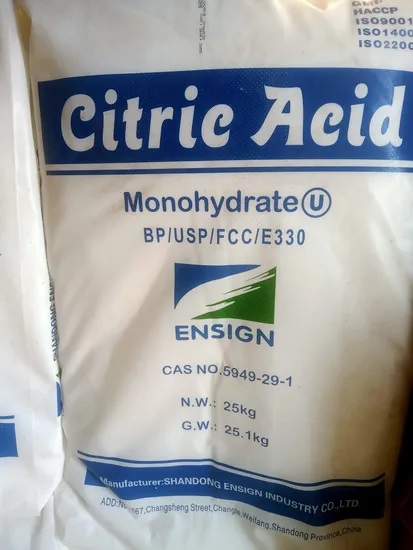|
 |
| |
Product Description
**Product Overview:**
Citric acid, in its white crystalline powder form, maintains a stable structure at room temperature. It can exist in either an anhydrous (water-free) state or as a monohydrate. The anhydrous variant crystallizes when exposed to hot water, while the monohydrate forms during crystallization from cold water. Converting the monohydrate to the anhydrous form involves heating it above 74°C.
Citric acid is also soluble in absolute (anhydrous) ethanol, with a ratio of 76 parts of citric acid per 100 parts of ethanol at 15 degrees Celsius. In terms of chemical structure, citric acid shares characteristics with other carboxylic acids. Upon heating beyond 175°C, it undergoes decomposition, resulting in the release of carbon dioxide and water.
|
Testing Item
|
Citric Acid Anhydrous
|
Citric Acid Monohydrate
|
|
Assay/%
|
99.5~100.5
|
99.5~101.5
|
|
Water/%
|
≤0.5
|
≤7.5~9
|
Sulphated Ash
(Residue On Ignition)/%
|
≤0.05
|
≤0.05
|
|
Sulphate/%
|
≤0.01
|
≤0.015
|
|
Oxalate/%
|
≤0.01
|
≤0.01
|
|
Calcium(Ca)/%
|
≤0.02
|
≤0.02
|
|
Iron(Fe)/%
|
≤0.0005
|
≤0.0005
|
|
Chloride(Cl)/%
|
≤0.005
|
≤0.005
|
Readily Carbureted
Substances/%
|
K≤1.0
|
K≤1.0
|
|
Arsenic(As)/%
|
≤0.0001
|
≤0.0001
|
|
Heavy metal(Pb)/%
|
≤0.00005
|
≤0.00005
|
|
Note: Special requirements of particle size should be negotiated by both suppliers and customers
|
Citric Acid Uses
**Versatility of Citric Acid in Food Production:**
Citric acid plays a multifaceted role in food production, serving as a flavor enhancer, preservative, and aiding in the ripening process. Approximately 50 percent of global citric acid production is dedicated to enhancing the flavor of beverages. In powder form, citric acid is incorporated into dry foods like seasoning salts, flavoring powders, and crunchy snacks to impart a desired sour taste.
Its acidic pH makes citric acid effective as a food preservative, preserving both the taste and color of foods by slowing down oxidation. Due to its ability to create an environment inhospitable to many bacteria, it is a common addition to jams, jellies, candy, canned foods, and meat products for preservation. In cheese-making, particularly mozzarella, citric acid facilitates the ripening process.
Beyond preservation, citric acid finds application in adjusting pH levels when brewing beer and wine, preventing fat separation in homemade ice cream, and averting sugar crystallization in caramels. A small amount can enhance the leavening power of baking soda, making it a secret ingredient for cakes and biscuits. For those on a low-sodium diet, citric acid can substitute for salt in seasoning.
Citric Acid Storage
Store citric acid in its original container in a cool, dry place. From the date of manufacturing, it has a shelf life of three years once opened and will stay stable for at least five years unopened.
Citric Acid Nutrition and Benefits
Citric acid has zero calories and fat but also no other nutritive values. While consuming natural citric acid from fruits and vegetables has health benefits-it helps metabolize energy and may protect against kidney stones-ingesting the manufactured version hasn't been proven beneficial to our health.
Citric Acid Packing
25kg/kraft bag or as required.
Free samples are also available for customers to test, and we will cover the shipping fee.
|
| |
| Prev:
Potassium sorbate
|
| Next:
L-cystine
|
|